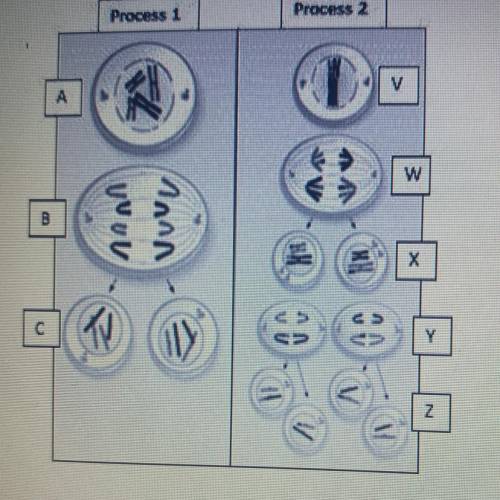
Biology, 12.04.2021 22:50, rosie20052019
ANSWER FASTTT PLEASEE!! Which of the following correctly identifies the two processes in the diagram?
A. Process 1 is meiosis, and Process 2 is mitosis.
B. Process 1 is mitosis, and Process 2 is meiosis.
C. Process 1 and 2 are both mitosis.
D. Process 1 and 2 are both meiosis.


Answers: 3
Other questions on the subject: Biology

Biology, 21.06.2019 16:30, lllleklfkhlsdf1201
As , plants meet their needs for making food from air, soil, water, and the sun's energy in a process called there are plants called grow high in trees without here are words to put in the blanks. 1.) producers 2.) consumers 3.) chloroplasts 4.) epiphytes
Answers: 1

Biology, 22.06.2019 02:30, 10033636
Acertain species of fish can have either long or short fins. the allele for long fins is dominant over the allele for short fins. a heterozygous, long-finned fish is crossed with a homozygous, short-finned fish. of the offspring, will have long fins and be , and will have short fins and be .
Answers: 2

Biology, 22.06.2019 06:30, ktown9
Zoo geographic regions are characterized by the presence of specific groups of animals these regions are determined by the taxonomic or phylogenetic relationships of animals. the map shows the zoogeographic regions proposed by the naturalist alfred russel wallace in 1876. the similarities of organisms in which two areas numbered above provide the best evidence for common ancestry between the organisms in both locations ?
Answers: 3

Biology, 22.06.2019 06:50, Shaylaharrison15
The kidney filters potentially toxic substances in the blood, and thus “clears” the blood of those substances. this clearance function is dependent upon and proportional to the diffusion gradient of the substance across filtering capillaries, i. e. if the concentration of the substance is doubled, twice as much will be cleared from each ml of blood that is filtered. suppose that the body produces a constant amount of a substance x per unit of time. the kidneys eliminate substance x at a rate directly proportional to the concentration of the substance and the volume of blood cleared each minute (c): elimination = c × [x], where [x] is the steady-state concentration of substance x. imagine an individual with an initial concentration of x equal to [x]0 who develops kidney disease. her baseline clearance c0 drops to one half of the original (½c0). what is the new steady state concentration of x? (for simplicity, assume that substance x is 100% filtered by the kidney).
Answers: 1
Do you know the correct answer?
ANSWER FASTTT PLEASEE!! Which of the following correctly identifies the two processes in the diagram...
Questions in other subjects:


Mathematics, 02.10.2021 01:50

Biology, 02.10.2021 01:50

Mathematics, 02.10.2021 01:50



Mathematics, 02.10.2021 01:50

Chemistry, 02.10.2021 01:50

Mathematics, 02.10.2021 01:50






